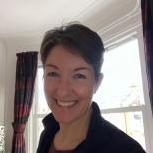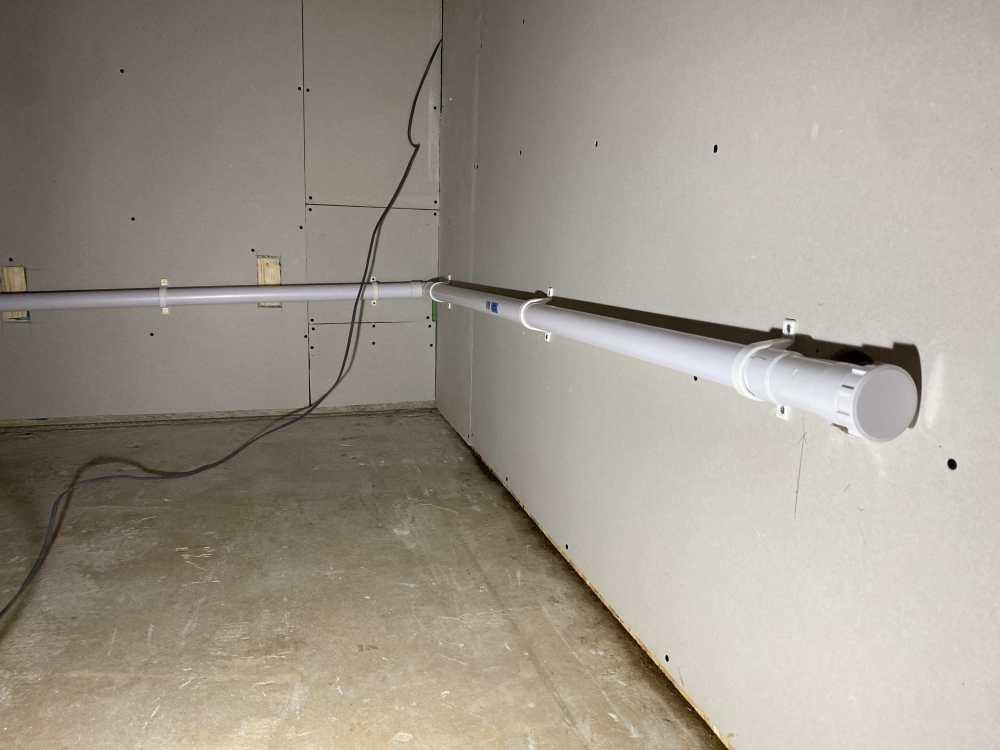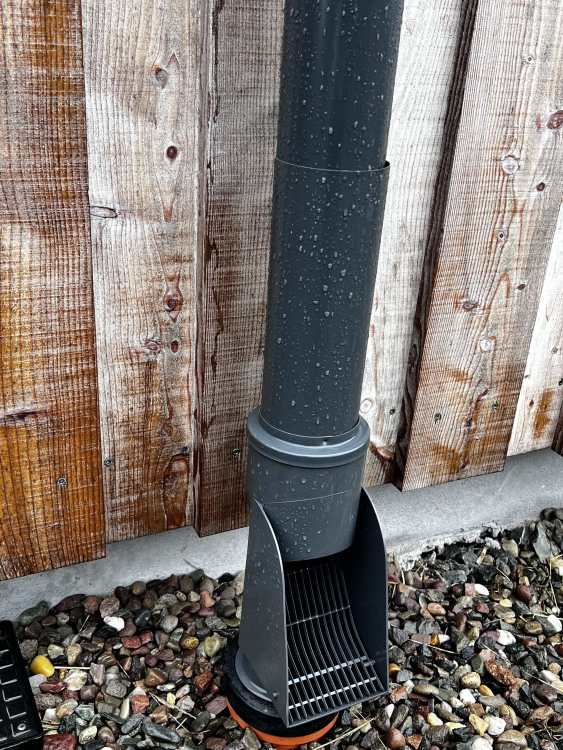Leaderboard
Popular Content
Showing content with the highest reputation since 10/31/25 in all areas
-
Last night was my first night sleeping in my new house, finally! Got 1 bedroom mostly finished. Ikea wardrobes, painted, blind and floor installed. Just enough to call it a home! Lots more to do but it saves rent and commuting time. I plan to take it easy for the next fortnight as the last two years have been creeping up on me. Small projects for the short term. Getting internal doors installed (by someone else!) currently. Put some acoustic insulation around the linings and cut it back. I like the look of the wood/oak veneer. Been chasing documentation for the BER (SAP) assessor. It adds up to quite a lot. Doors, Windows, Heating systems, section plans, U value calcs. Think I have all of it now - hopefully they'll issue a BER Cert soon! My airtightness commission went sideways, lots of leaks. So one of my snags is to put air tightness tape around all the ducts to the MVHR unit and outdoors and also between it and the manifolds. The testing unit is very sensitive (even dropping it puts it out of commission for two weeks!) so I've a bit of work to do before I call them back. The Renson Endura Delta 330 has a few levels of ventilation and they upped the minimums from 50m3/hr to 127. Will see with single occupancy if I adjust this down a bit. I can monitor the unit with an app only, there's no display. I noticed when I ran the supersayer gas heater for a few hours to warm the house (as the gas bottles had been unused for the last two years) the CO2 levels hit the roof and it went to max flow rate to clear it out. Anyway, I plan to use the Air to air system more going forward and that won't cause the same issue. Had two floods to deal with. I've a japanese bath I was trying out. We'd filled the bath with a little water to check for leaks a few weeks ago and it drained fine. The bath is on a platform to allow for a trap to be installed below it. The drain for the bath just fits into a grill so it's open and can potentially overflow which is what happened after I fully filled it, used it and two days later pulled the plug! Luckily I put the plug back in and used towels to keep the water in the bathroom as it's tanked / is a wetroom so no damage was caused to the rest of the house. There is a seat in the bath so I was trying to get the most comfortable position and removed the seat. I'll probably put it back as it's a short bath and my back didn't like the sitting position on the floor of that bath all scrunched up. The seat means you only get heat around your hips so will have to have a think about it more at some stage. Or get a bigger bath! The second incident was with the washing machine last night. The discharge pipe isn't big enough for the tumble dryer, air to air condensate and the washing machine so I got an adapter that taps into the side of the pipe with a spigot for the washing machine discharge. This didn't seal/hold so it spilled everywhere. I think I'll go back to basics, replace that section of pipe and glue on a y bend to create two parallel discharge pipes and this way I can get everything connected at once and no risk of floods! My car charger won't reach the car as it's about a meter short but that's due to a big hole I've to backfill with MOT. The dust is everywhere but at least with the internal doors I can mitigate this a bit going forward! So not finished yet but I have a doorbell, hot water, heating and an amazing house to walk around in and rest a bit before finishing the final list of projects and call it a day!10 points
-
6 points
-
This day has been on my mind for months. We really struggled to find a company that would visit the site and confirm whether we could get a static down the lane. In the end we took an educated guess and purchased a 2023 37x13 unit from a private seller. So at 1100hrs today, the wife of the driver (Greg Caravan Haulage) appeared in the driveway telling me I needed to go and cut some low hanging branches. We got the static on site relatively easy, but then it got bogged down twice whilst reversing it over the type 3 MOT. We had to Jack it up and then finally decided that sheets of 18mm shuttering ply under the wheels might be the way forward. In a nutshell , if we’d done that from the start we’d have got it done much quicker. It’s in position and I just need to get it levelled and on blocks now. A bit too stressful for my liking, but relieved. I’ve been more concerned about getting the static on site, than building the house.6 points
-
6 points
-
Self-cleaning is a bit of an overstatement by Lindab although the debris does end up in a neat pile in front of it. My only criticism of it is you need three bits. The downpipe, a shoe and the self cleaning trap. Four bits in my case as I also used one of those rubber boots. The plus side was I was able to use a single run of downpipe as the shoe and trap added length.5 points
-
Aero barrier have been and gone. initial air changes per hours was 1.7 builders did an excellent job and AB guys were impressed. after their magic mist was finished, they got it down to 0.2.5 points
-
I'm sorry but this comment feels off. You (and we) are getting huge amounts of input from this forum. It's by asking questions and getting others inputs that we learn......the answer may not always be what we were expecting but that doesn't mean it's wrong. So rightly or wrongly I am offended for @Nickfromwales And as to the question at hand good luck with your project. From our perspective there is no way that we'd let anyone near site (knowingly) that didn't know what bits to bring. Maybe because I haven't had my second coffee yet, but right now, not feeling like I'll bother to share any experience (as hands on self builders, mid project) with you right now.4 points
-
Thank you all for your advice, I spoke to the architect today and he has agreed that block and beam isn’t required. To be fair to him, he hadn’t finalised all the drawings as there have been some too’ing and throwing between him and SE and he did state it required a re-design. If I hadn’t of come on here and sort advice I’d of probably let it go. Maybe the architect may have changed it regardless but at least I was forearmed. thank you all again. i am sure i will have many more questions to come considering i am very early in to the project 🙂4 points
-
4 points
-
I love problem solving and you cannot beat the feeling of doing so via improvisation. Getting on site in the next 3-4 weeks is going to be a big relief. Having to travel 1hr each way has been a real drag and I think that even though we are moving into a static caravan. It will be into a static caravan that we own on our land and the place we will call home. Living in rented for two years, has felt like living in limbo.4 points
-
There’s no particular reason for UFH pipes to fail under normal use. Every house I’ve lived in with rads have had leaks. Other than the obvious benefits an often overlooked benefit of UFH is the practicality of no rads on the walls so it makes room layout better. I’ve also simplified our heating system so there’s nothing overly complex about it. We’ve done the wall of South facing full height glass, big West facing picture window, and big full height picture window in a small bedroom. There’s no doubt it has some impact in the hot summer days and on cold dull days (especially the bedroom) and less glass would have been better from a performance point of view. But houses are a compromise between aesthetics, performance, and how they make you feel and I’d rather have the view and live with the minor downsides. That said the heating has only really started to come on in the last week. Had we built the house with a performance at any cost perspective we’d barely need heating at all. Interestingly, despite us running the house relatively cool, all our friends, who live in old cold stone buildings, find it too hot.3 points
-
Don't go near CEF or any of the other big boys, seek out a small indy wholesaler- or just go to Screwfix...3 points
-
Are you building via your business or another company setup to solely to build house? Not sure how that works as the company is a different entity to yourself in the tax world. The company would build for you, the client. But company needs to a building company not consultants as way of an example. Suspect it will be way more complex than it needs to be and possibly cost you more.3 points
-
Hi All, Based in the South East, in a seaside town called Whitstable, which falls under Canterbury City Council. Back in 2022, I purchased a commercial barn with the dream of converting it into a home. When I first bought it, I (naively!) thought the planning process would be fairly straightforward under permitted development rights. Unfortunately, that wasn’t the case, the barn was considered to be curtilage listed, which meant a much longer and more complicated route through planning. After a couple of years of back-and-forth emails, refusals, research, and learning far more about the planning system than I ever thought I would, I’m happy to say we finally got permission granted this May for the change of use from a commercial workshop to a residential dwelling. This will be a self-build project, and I’m just starting to look into materials and suppliers with the hope of kicking things off before the end of the year. That said, there are still a few more surveys and bits of planning bureaucracy to sort through first. No doubt I’ll be here soon asking for advice (and probably pulling my hair out along the way), but I’m really looking forward to learning from everyone and sharing progress as things move forward. Thanks for having me, Leon3 points
-
After a dry summer and minimal progress, we are getting a roof on at last... in foul weather. Fortunately the cladder doesn't mess about and has hired in this very serious kit. Hence 350m2 on plan was clad in 2 days. Huge crane with panel clamp, big mewp and don't forget the forklift off to the right.3 points
-
It will feel overwhelming and you’ll have to pace yourself because everything takes so long. Money flows out at a rate - but at least you won’t have rent to pay with the static. We’ve friends who are self building from a caravan. They put a yurt up May-October every year (4years and counting!) and that doubles their living space for half the year. Might be an idea? On a tight budget you’ll need to do tons yourself - almost every job is doable but work out where you need skills and look for those people early (that was groundworks, plasterers and tilers for us). The pad by the bed is an excellent tip - so many nights waking 3am when there’s something forgotten or needs answering. It is a scary ride but also amazingly fulfilling. But you do have to pace yourself - I’d say it’s really difficult because you’ll want to move it forward all the time but try and schedule normal stuff in every so often. I’m having my first day off work/off site for many weeks today (catching up on build hub 😆) and the mental break being away from site feels amazing. And it’s only 9am! Keep a diary and you might even want to blog here. Realising how far we’ve come is more important to me than what’s still left to be done. I often flick back to pictures from a year before (founds in, timber frame was going up) when I’m feeling fed up - just to remind myself we’re getting there (on painting, 2nd fix and floor laying now). Good luck!3 points
-
You will have many more stressful days like that. just think how that plywood saved the day, then every time you have a day like this planned think what could go wrong, and what would save the day, whatever you think will save the day make sure you have it ready. it could be an extra man on concrete pour day or that stack of 4x2 that you found free on Facebook, get it all ready you will find the majority of lads are used to solving problems.3 points
-
We got our final building regs sign off approval today so that’s us technically finished. Yay. Feeling quite relieved. It’s taken just over 4 years from when we first set foot on the land till now. What a ride. 😂 Thanks all. Buildhub has been awesome.3 points
-
Just introducing myself as a new member. Retired now and basically a DIY-er looking for some guidance on issues re potential new single storey extension. Hope at some stage I might also have something to contribute to the forum. Thanks. Bob2 points
-
I would echo the above with respect to Openreach - we had ongoing problems for about 6 months with BT trying to establish a connection. The Openreach fools engineers turning up, assessing the job as needing to go on the 'too difficult' pile, and making excuses not to do it. I made a complaint to the Chief Exec of BT, and this got me a complaints handler who persevered like nobody's business to see this through. In the end, the connection was made. The heroes engineers that did it accidentally gave away that this one had been in their office for some time, and no one wanted to do it as it was hard. At the end of all of that palaver, we received over £700 compensation (the statutory amount per day), which paid our broadband bill for more than two years. In the interim, we were using an EE 4G dongle which worked really well, despite the 4G signal here being a bit iffy.2 points
-
Not for residential use yet. OneWeb is LEO based but mainly aimed at commercial use (last time I checked) There are a few other LEO systems planned to compete with Starlink (Amazon for one) Plus there are some high Earth orbit services but they have much higher latency (hundreds of ms) so not that useful for residential use.2 points
-
Where the rad is missing, you need to bleed the air out of those tails. If the problem then persists, turn the TRV of EVERY other rad 100% off and leave the rad not working 100% on, and run for 30 mins. Once (if) you see heat getting to the lazy rad, then open the rest of the TRVs back up and put the telly on.2 points
-
TLC are good if you have one locally. Quite competitive on most things and their pricing is very transparent- all on the website. I don’t get much of a discount even spending 5 figures there per year as their prices are already quite good. CEF on the other hand…2 points
-
It is good to have a grille between the gutter and the surface water sewer to trap leaves etc. No need for a trapped gulley. Rodding is never likely to be needed although you may get roots invading and it is best to have some access to deal with this.2 points
-
How far is it too the outlet, could you clean backwards ? nothing of what you linked to is necessary you don’t need any form of trap, and don’t need any form of gulley 110mm pipe then a rest bend then a bit of pipe and a square plastic grid. if a blockage occurs you lift the mesh lid and stick the hosepipe down it. if you have a long run parallel to the house you could put a rodding eye on the end if you wanted. no solids going down it just some dust from the gutters. and no smells coming back up. just be sure the ditch doesn’t overflow and back up your pipe, you might need a flood prevention valve on the end.2 points
-
Agreed the first priority, but if you have great views and have maximised glazing (it happens - me for example) solar gain can still be an issue, especially on a no wind day. So active cooling is great over and above that. First what complex controls - some do this but they are not needed. My heat pump for example runs as a single zone fully open system, all UFH in the house and a fan coil in an insulated summer house. Effectively one valve in the system a diverter to cylinder or heating system. During winter it runs pure weather compensation all driven by ASHP controller with no external controls. Only thing to go wrong are the heat pump or diverter valve. In summer exactly the same almost, but now it runs in Weather Compensation mode but at a fixed temperature, no more controls in the system. Heat pump just senses return water and reacts when it sees return water getting above a preset temperature. It works well, it's not Aircon, but let's the house recover from solar gains quickly and more importantly limits the ultimate temp the house reaches, so it remains comfortable. Only control in the system outside of the heat pump, is to switch from cool to heat, I used a light switch to give heat pump volt free contacts an open or closed signal. Pipe life. During heating the pipes may see 36 degrees water and during cooling the target flow temp is 14, during a compressor cycle this temp can dip to nearer 12 degs. So neither temperature is going to shorten the expected life span of the pipes or valve. Similar the pipes out of the floor, a mix of copper and Hep2O are all in the normal and expected range of operation and a mile away from the max and min allowed. Do not expect any issues there either. The system as configured with no zone valves on the manifold or in the system, which makes it more reliable than a normal system, as there are no pins to stick on the manifold from valves being in a closed position over the summer. Or pumps or mixer valves locked for the same reason - as I don't have any of those either. So for clarity system is ASHP Diverter valve controlled by ASHP DHW Cylinder UFH manifold UFH pipes Fan coil teed into main system flow and return. A 50L volumiser on the return piping to extend cycle time of compressor. A zero volt switch to select heat or cool.2 points
-
For what it's worth, we're taking a different approach on the project I'm currently working on (it's a roughly £3m-£4m project) Hiring a PM/CM/QS team to run the project and subs PM/CM/QS team will be paid a fixed fee for the project (we have divided the project into set payment milestones also, to de-risk for client and keep incentives aligned: e.g. demolition, groundworks, etc) They will assist in hiring the prelims (site manager, welfare, etc) and oversee project on day-to-day basis. All subs will then be tendered and hired on fixed-fee basis (everything will be itemised and costed by QS) This means we take on the main contractor risks (and their margin also) - but still keep the tradies working on fixed-fee - which is the only way. Essentially, we are acting as main contractor. I've been talking to someone recently who ran a big high-end project on open-book with a main contractor (and they've done many projects previously), it's been a disaster. I couldn't recommend this approach or see it working unless the client is highly experienced with many years in the game and has a trusted partner to act as main contractor, and even then I'd be skeptical, the incentives are simply too misaligned (even if they don't appear to be).2 points
-
You may want to rethink that a bit for your project.....yes you can get good prices online, but you can't always get things as quickly as you need them, or if something crops up or understand all the alternative, which takes time if your hands on with the project "doing". We've established relationships locally (we would like money to stay in local area if we can) been straight and told them that, but also that we are looking for a "sensible" cost, and made no bones about that fact that we do check prices online. So far, its worked for us, and when there has been a need for a quick response they've come up trumps. Also set up accounts, if nothing else it helps cashflow.2 points
-
Even with the best intentions I'd think really carefully before going down this route (bluntly I just wouldn't go this way) as it's very likely to complicate your dealings with HMRC, who will look at the arrangement between connected parties and, in addition to the paperwork @JohnMo listed, may ask you to show that the relationship is truly commercial - for example, if they believe the company may have charged its director below market rate etc, undercharging and offsetting that against other sales, suggest you owe tax and NI on any discount they assign. "Dear HMRC, I'd like to use my limited company to avoid personally paying reclaimable VAT on my self build at the point in time it would normally become due. Is that okay?" - does that sound like a good starting point, or a discussion you want to get into later with 10Ks - 100Ks at stake?2 points
-
Running one 400mm wide layer of say 50mm along the wall plate will give a nice controllable ‘straight edge’, then butt the next 100mm against that and roll that out, and there’s you pitched layers of insulation managed in the eave where it’s a git to get in to and detail. Then overlay as you wish to get to the minimum 300mm stated. After 300mm it’s assumed that the weight of any further layers will start to compress the bottom (first) layer and then that layer becomes far less effective. Wool needs to remain as decompressed as possible to function best, so those stilts from the sheds to raise the attic flooring up and over will defo be needed if you intend to store anything up there (which requires a deck and walk/crawl areas).2 points
-
+1 Add more wool type on top of the existing. If he currently has insulation on the floor of the loft then the loft space itself is/should be ventilated at the eaves. Typically air enters at the eaves on one side, goes across the loft above the insulation and out at the other side. The idea is to remove any water vapour that gets through the plasterboard and insulation and prevents it condensing on the rafters. This is sometimes called a cold loft. If he adds more insulation on top he should try and preserve a gap at the eaves. There are eaves tunnels available to maintain this gap allowing you to stuff insulation down in there without blocking the ventilation. If he wants to convert the loft from the above cold loft to a warm/heated loft then its not as simple as adding foil insulation at rafter level. You normally have to redesign the ventilation scheme. How you do that depends on the type of roof membrane. In many cases you must create a 50mm deep ventilated void between the rafters and replace the ridge tiles with a ventilated ridge. eg so air can enter at the eaves, go up this 50mm void and exit at the ridge. The amount of insulation needed between and/or below the rafters is considerable and needs to be calculated. A single layer of a foil type insulation won't meet Building Regulations. You at least need a layer of rigid foam insulation as well. A random combination of insulation some at rafter level and some at floor level would be ineffective, and potentially damaging in the long term. Avoid spray foam in the loft at all costs. Sadly too many cowboys about and many mortgage companies won't lend on houses with it installed. The main issue is it messes with proven ventilation strategies mentioned above. There are ways it could be installed without issue but mortgage companies don't seem to appreciate the subtle differences. Some people have had to get it removed just to sell the house.2 points
-
Nearly. The loss of efficiency comes from the liklihood that cool return water is mixed with warm flow water thus reducing the flow temp to emitters relative to the ft from the heat pump. Since the flow temp to emitters governs their output, you need to increase the ft from the heat pump to compensate. The cop of a heat pump reduces with increased ft hence loss of overall cop. It an be made to work with little or no loss, but for that the water in the buffer needs to be properly stratified, which has implications for buffer design and size, and the pump rates also need to be controlled. This (it seems) almost never happens presumably because the people who know how to do it properly also know how to design out a buffer in almost all domestic situations. The typical dumpy 50l buffer is unlikely to have any material stratification.2 points
-
Yes agreed. So best to get it sorted now. Installer called me right up after sending the report and was happy to engage and work to remedy issue in manner I'm happy with. So we will get there in sure.2 points
-
thanks for the replies, given me a bit of food for thought. its all internal so no cold bridging issues as such. great forum, always pops up when i google building questions, so thought i may as well join up. carl2 points
-
I have the Zehnder enthalpy exchanger in my Q600 unit. This decision was based on my understanding that in a large volume house with low occupancy, there was potential for the air to get too dry. See thread linked below with post from @Dan F @lizzie changed her MVHR to an Enthalpy core, due to excessive dry air. Zehnder webinar, with is quite interesting, has Q&A at the end.2 points
-
More like a few hundred plastic straws in matrix. Real advantage of enthalpy units is in prolonged sub zero temperatures where internal air can become increasingly dry. I monitored our air for 2 years with a normal exchanger, the air never gets to the really dry stage and we are in Scotland. So not sure I would bother getting one for the aded cost and benefits in the UK2 points
-
Thanks for the advice everyone. Just a little update on my VAT reclaim - as you advised, although the HMRC form does ask when you moved into the house, there was no issue with the fact I had been living in the house for a number of years prior to sign off. I am delighted to have now received my VAT reclaim.. well, 95% of it at least - strangely HMRC rejected my invoice for LED downlights stating I couldn't claim for 'bulbs' (!) & rejected a couple of other VAT invoices that they suggested were sales invoices, despite the fact they are clearly marked as VAT invoices. I have appealed those so will see how it goes. I found the whole reclaim process pretty straightforward - if a little time-consuming - but the money was in my account within a month of my application which was great.2 points
-
Can you not drill down through several layers of bricks and resin bond studs in place and then bolt the wall plates down or something similar - subject to calculating uplift loads.2 points
-
Hard landscaping almost finished, needs pointing. Bit of fencing to do between the house and garage which I’ll use the leftover larch cladding to match the house. Many tonnes of gravel to put down on the driveway, a few tonnes of topsoil then a load of planting to do along the line of the patio to soften it all. Planted my first two trees. Silver birch and a Willow.2 points
-
Try to make living there more pleasant look for some patio slabs free on Facebook, build a small patio, build a path to the washing line, put up a small shed that you take your boots off in and work clothes, if the wife starts walking mud in it will start eating in to the dream. build good steps to the static, keep her warm and happy and you can probably put up with the house build.2 points
-
OK!! Give us the depth you have to play with, from slab up to FFL please, as there's a lot of info but it's all a bit tricky to correlate. And why electric UFH? It's the most expensive thing you can run, and is this for supplemental heating or full-on space heating?2 points
-
Hello webby. Thanks for a good post and the work you have put in. I've attached a document from the RICS which is to do with spray foam insulation. This might seem a bit odd as at first glance it has got nothing to do with your post. But read the last paragraph of page 4. Then look at the diagram on page 5, then read around. For all on BH, it's also a good guide to help you understand some of the basics about roof insulation. @webbythewebster. Here is a bit of a lay persons guide to insulating an old loft. Let's say your Dad's ceiling is just plasterboard, painted but with no vapour barrier and it's got say 100mm of glass wool at the moment. I'm going to call simplistically water vapour a gas. When the gas gets cold enough the water gas turns into water drops and at that point the problem starts. Gas molecules are farther apart and move more freely than liquid molecules so they can get out the roof more easily. The paint (may have some gloss paint) acts as a bit of a vapour barrier. The loft space may have some ventilation but not that much. When the weather is cold some moist air will penetrate the ceiling and now and again, depending on the temperature in the void above you will hit what is called the dew point. This is where the water vapour turns from a gas into a liquid. Now when the insulation is only 100mm thick this won't happen very often. The water gas will keep migrating into the roof void and escape more easily. The insulation will get a bit wet from time to time but it often dries out in an old roof. The techy bit is called the dew point. This is where the water gas turns to a liquid. Like when the gas in the clouds turns to water and it rains. In the thinner insulation the dew point will occur less frequently and the gas will just exit the roof more often without causing any harm. But to bring a roof up to modern standards we are looking at (350 - 400 mm in Scotland) and a say 300mm in England, this insulation comes in standard thickness. Here you can see that the loft will be much colder as you have added insulation. As the insulation is thicker the dew point will occur more often within the depth of the insulation and the insulation will become wet more often. Wet insulation against a timber roof don't make good bed fellows. To solve this we need to make the roof void much more drafty.. by installing more roof vents so it dries out the thicker insulation and reduces the time that the roof timbers are exposed to moisture. The big problem with this is that the foil is impermeable. We know that at some point we will get the water gas turning to water drops. The foil stops this water from venting out into the loft and then out the roof so it is trapped and will rot the timbers. @webbythewebster To upgrade the loft insulation, it sounds counter intuitive, you need about 300 to 400 mm of glass wool and then increase the ventilation to the void. The loft will become much colder, but the house will be warmer. Here is a link to a free calculator that you can play with. It also chucks out a basic condensation analysis. https://tools.knaufinsulation.com/en-GB/tools/u-value-insulation-calculator But why is this product to be treated with extreme caution! Basically, because if it is laid on top of insulation is stops the water that has condensed within the insulation and then turned back to a gas when the weather warms up (evapourated say) from getting into the loft void and out the roof. For all, and the teckies. At some point many buildings will, depending on the weather get condensation happening in the depth of the structure. If we try and avoid all cases we end up over designing and that costs you money. For the really tecky we have what I would call a reverse condensation effect.. few if any condensation models take this into account. Your house outer pane of glazing is cool, a warm weather front moves in from the west, it's misty, you can see the mist with the eye. This mist / humid air penetrates the wall and condenses from the outside in! @webbythewebster To save money the easiest target is the loft. But you need to ventilate more. Have you explored whether your Dad can get a grant for this work? RICS Spray foam insulation downloaded 31-10-2025.pdf2 points
-
Just wanted to report back on the £20 Sentry. Well its very surprising and we have noticed a huge difference! I've not had to scrape scale off the kitchen tap at all and the kettle we have in the Airbnb which is in frequent use has only been descaled once rather than weekly. Of course our water isn't softer but the limescale has definitely reduced in that it isn't sticking to things any longer! I'd definitely recommend it.2 points
-
We got a kitchen on supply only. The after sales service has been diabolical. More than not recommending, we will be actively discouraging anyone who asks to avoid them like the plague.2 points
-
You have understood and explained beautifully. As has @JohnMo It is highly marketed, stopping just short of untruth. Bubble wrap for sheds or greenhouses. In case he needs further convincing... reflective surfaces need to reflect back to an air space to perform. Squeezing lots together doesn’t work. And condensation could cause problems. Interesting that it has dropped in hype from 'the most amazing development,' to the Aldi aisles.... For more insulation, add more fibreglass to the loft floor, perhaps the opposite direction to what is there.2 points
-
A normal loft needs a draft to stop the roof structure getting damp and rotting. The roof structure should be left well alone. He needs to ensure the eaves are left open to provide this air flow. To insulate use normal loft roll ideally insulated to a thickness of about 300 to 400mm in alternating layers. If he needs a floor above the insulation B&Q etc sell brackets that extend through the insulation so as not to compress it. Bubble wrap isn't going to do much - ok in the green house, but that's about it.2 points
-
Oh in that case the Ubiquiti suggestion is a good one. Building to building links is one of their business focuses. A number of other companies in the space too but the names escape me right now.2 points
-
Thank you! Yes, I've just been tied up with a manic work week and your earlier post also sent me down a rabit hole to dig out and digest the original structural scheme, which I realised had been completed by 2 structural engineers. The 1st was regarding the whole house design, in particular the steel frame and founds, but also the wind uplift on the connection between the masonry ground floor and the upper floor timder frame. They then passed on the structural design to the glulam beam manufactureres who also completed there own uplift and load calculations for the beams spanning approx 7m on the longest side. I know the first onces erred on the side of caution, but know quite know the other - I will have to look through their report too. However, as I digest all this, I'm erring towards the alternatives suggest because: Yes, this is what the smaller side of the roof looks like - I completed the flashings pretty robustly by making a series of smaller single welt panels. Ridge and eaves went a little ott too. It's a 'proper' standing seam, hand folded with a double lock, so it has floating clips to allow expansion and contraction and this is significant as the panels are over 8m long on the longest side. Exactly, could agree more! This is now rapidly becoming my conclusion given all the input here. Yes, the solar panel side of things wasn't covered off at design stage at all, unfortunately, but it alos comes about because the solar designs sees a surface and just wants to use it all - doesn't see the risks until there's silence from the roofing contractors. For me, I'm feeling lucky that I didn't get a cowboy outfit that said they'd happily do it. And now I'm rapidly concluding that we should go in a different direction with this. I don't like the look of the fixings I've found, particularly given the curve as they won't sit completely flush to the seam and therefore may not be able to fully lock onto it as intended and I like even less the small ones with one grub screw that will inevitably damage the surface coating. All in all, I so appreciate the input here as it's been invaluable, thanks!2 points
-
We are incredibly lucky. We overlook the Strathmore Valley with the Sidlaw Hills in the distance. Because we are quite a way up the North side of the valley we are often above the clouds. It can be quite ethereal at times.2 points
-
I applied for the final building sign off yesterday so we’re done as per the building warrant. Consequently I’ve given the question of would I do it again a bit of thought. Despite all the issues and stress I’ve changed my mind and would do it again. We love our house and it’s just about perfect for us. There’s one design flaw with it that we always knew was there (no muddy boot room) but other than that the house is working as we hoped and better in some ways. I would do it very differently next time though. We thought the approach we took would reduce the risk and stress but it was the complete opposite. My other half wouldn’t let me though so this is it until an kark it.2 points
















